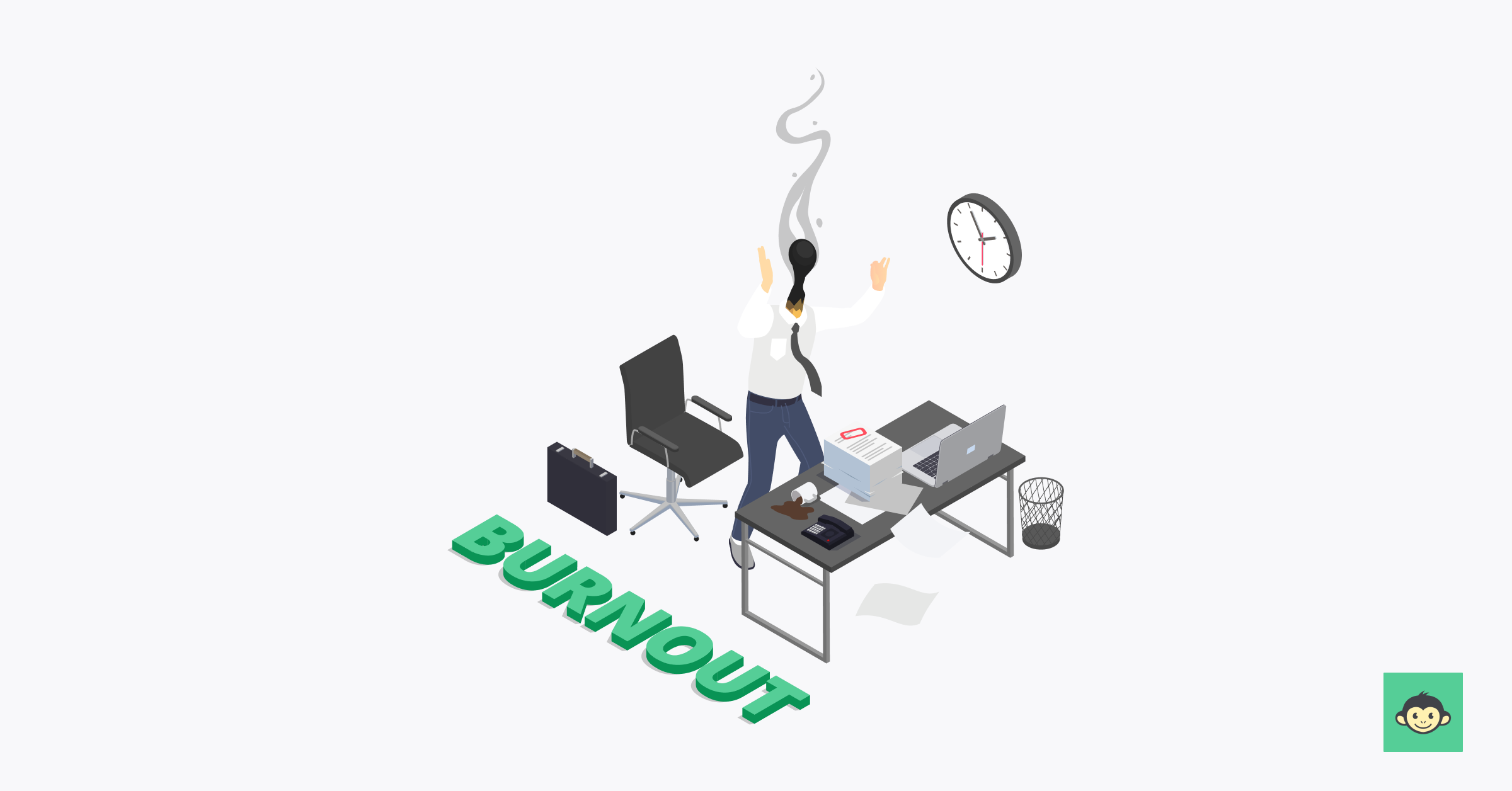How to spot employee burnout signs: A complete guide

Exhausted, overwhelmed, and devoid of motivation, countless employees find themselves on the brink of burnout. In today's fast-paced and demanding work environments, it's becoming increasingly common for individuals to experience the negative effects of prolonged stress.
But how can you identify the signs of employee burnout before it takes a toll on productivity and well-being? It's not easy, as the renowned author and psychologist Carl Jung once said, 'The shoe that fits one person pinches another; there is no recipe for living that suits all cases.'
However, some early indicators of burnout could be chronic fatigue, where employees feel tired even after a good night's sleep or decreased job satisfaction.
Zippia reports that 89% of employees have experienced burnout within the last 1 year. While burnout may manifest differently from person to person, understanding the common indicators is crucial in supporting colleagues, managing workplace stress, and fostering a healthier work environment.
In this blog, we will dive into the ways of recognizing and avoiding burnout in organizations.
What is employee burnout?

Employee burnout refers to a state of chronic physical and emotional exhaustion resulting from prolonged stress in the workplace. It is a response to overwhelming work demands and can significantly harm individual employees and organizations.
Burnout is characterized by a sense of depletion, reduced motivation, and a decline in job performance. It goes beyond ordinary work-related stress and can impact various aspects of an employee's life, including their mental and physical health, relationships, and overall well-being.
Stress and burnout are not limited to employees who work from the office and significantly impact remote employees too. Zippia reports that 86% of employees who work full-time from home have experienced burnout.
Why should you take employee burnout seriously?

Work-related burnout is a pressing issue that requires attention and proactive measures to prevent and address, ensuring a healthier and more productive work environment.
First and foremost, burnout has a direct impact on individual employees' well-being. It can lead to mental health issues such as anxiety and depression, physical ailments like chronic fatigue and weakened immune systems, and an overall decline in quality of life.
Employees experiencing burnout are more likely to take sick leave, leading to healthcare costs, increased absenteeism, and decreased productivity.
Furthermore, it negatively affects organizational performance. Exhausted workers and disengaged employees are less motivated, less productive, and prone to making mistakes.
This can result in reduced efficiency, lower quality of work, and decreased customer satisfaction. Ultimately, it can harm the company's bottom line and reputation.
Failing to address burnout can also lead to a higher turnover rate. Employees who feel undervalued and overwhelmed are more likely to seek job opportunities elsewhere, resulting in recruitment and training costs for the company.
By taking burnout seriously, organizations can create a healthier work environment that promotes employee well-being, job satisfaction, and productivity. Prioritizing employees' mental and physical health benefits individuals and leads to a more successful and sustainable business.
What are the five symptoms of burnout?

While burnout can manifest physical symptoms differently in individuals, there are five common symptoms to watch out for:
1) Exhaustion
One of the primary signs of burnout is persistent fatigue, both physical and emotional. Employees may feel drained even after adequate rest and experience a lack of energy throughout the day.
2) Decreased performance
Burnout often leads to a decline in job performance. Employees may struggle to concentrate, make more errors than usual, and find it challenging to stay focused on tasks. This drop in productivity is a clear indicator of burnout.
3) Detachment and cynicism
A sense of detachment from work and colleagues is another symptom. Employees may become cynical, expressing negativity and disengaging from their work environment. They may also withdraw socially, distancing themselves from coworkers.
4) Increased irritability and frustration
Burnout can cause individuals to become more irritable, short-tempered, and easily frustrated. Small issues that were previously manageable may now trigger strong emotional reactions. This emotional instability can affect working relationships and overall team dynamics.
5) Physical and mental health issues
Burnout often takes a toll on both physical and mental health. Employees may experience frequent headaches, muscle tension, and compromised immune systems, leading to increased sickness. Additionally, mental health problems such as anxiety and depression can arise or worsen due to prolonged burnout.
Recognizing these symptoms is vital for identifying and addressing burnout promptly. By doing so, organizations can provide the necessary support and implement strategies to prevent further deterioration of employees' well-being and job satisfaction.
10 Common causes of employee burnout

By understanding the causes of burnout in employees, organizations can take proactive measures to prevent them from happening. Here are the top 10 causes of burnout.
1) Workload: Excessive workloads, unrealistic deadlines, job-related stress, and a constant feeling of being overwhelmed can lead to burnout. Employees who consistently face unmanageable work are at a higher risk.
2) Lack of control: When employees feel a lack of autonomy or control over their work processes, decision-making, or schedules, it can contribute to burnout. Feeling powerless and micromanaged can be highly detrimental.
3) Work-life imbalance: The inability to establish a healthy balance between professional and personal life can lead to chronic stress and burnout. Long working hours, limited time for personal pursuits, and neglecting self-care can take a toll on employees' well-being.
A study by the world health organization shows that long working hours led to the death of 745,000 people.
4) Lack of support: Insufficient support from managers, colleagues, or the organization itself can exacerbate burnout. When employees feel isolated, unappreciated, or unsupported in their roles, it can contribute to a sense of exhaustion and disengagement.
5) Unclear expectations: When expectations are unclear or constantly changing, employees may struggle to meet them. The resulting uncertainty and pressure can contribute to burnout as individuals grapple with the fear of failure or disappointment.
6) Organizational culture: Toxic work environments characterized by excessive competition, negativity, or lack of respect can foster burnout. A culture that does not prioritize employee well-being and work-life balance can contribute to a high-stress environment.
7) Lack of recognition: Employees who feel their efforts and achievements go unnoticed or unappreciated are more susceptible to burnout. The absence of meaningful recognition and rewards can diminish motivation and job satisfaction.
8) Job mismatch: When there is a significant disconnect between an employee's skills, interests, and the nature of their work, burnout can occur. Feeling unfulfilled or lacking passion for their current job can contribute to chronic stress and disengagement.
9) Absence of growth opportunities: A lack of professional development opportunities, limited chances for advancement, or feeling stagnant in one's career can lead to burnout. Employees thrive when they can see a path for growth and advancement.
10) Poor work relationships: Negative or strained relationships with colleagues, superiors, or subordinates can contribute to workplace burnout. Interpersonal conflicts, a lack of collaboration, or a sense of isolation can significantly impact an employee's well-being.
How should companies deal with employee burnout?

Addressing employee burnout requires a holistic approach that involves proactive policies, supportive leadership, and ongoing monitoring of employee well-being. Let’s take a look at the top 5 ways companies can prevent employee burnout.
1) Foster a supportive culture
Develop a culture that prioritizes employee well-being, work-life balance, and open communication. Encourage managers and leaders to actively support and listen to their team members, creating an environment where employees feel valued and supported.
2) Encourage work-life balance
Promote work-life balance by implementing policies that support flexible working arrangements, time off, and regular breaks. Encourage employees to disconnect from work during non-working hours and set realistic expectations for workload.
3) Recognize and appreciate
Regularly acknowledge and appreciate employees' efforts and achievements. Implement recognition programs that celebrate accomplishments and foster a positive work environment.
4) Address workload and time management
Evaluate and address excessive workloads, ensuring that employees have manageable tasks and realistic deadlines. Encourage effective time management practices and help employees prioritize tasks to prevent overwhelm.
5) Promote autonomy and empowerment
Provide employees with opportunities for decision-making and autonomy in their work processes. Empower them to take ownership of their roles and projects, fostering a sense of control and purpose.
How to motivate burnt-out employees?

Motivating burnt-out employees requires a compassionate and tailored approach. Organizations must learn to acknowledge and validate their feelings, letting them know they are understood and recognized. They must also provide support through resources like counseling services or wellness programs and ensure employees are aware of these options.
Companies should also adjust workloads by redistributing tasks or revising deadlines to ensure employees manage their work comfortably. At the same time, fostering autonomy by involving employees in decision-making and allowing them to have more control over their work is non-negotiable.
Another easy way to prevent burnout is to set realistic goals and celebrate incremental progress to boost morale. Managers must also strive to cultivate a positive work environment that encourages teamwork, open communication, and recognition.
How to reduce burnout for managers?

Just like normal employees, managers can also fall prey to burnout which might negatively impact not only their performance but also their team’s. So, here are seven ways to reduce burnout for managers.
1) Delegate and empower: Managers often experience burnout due to an overwhelming workload. Encourage delegation and empower team members to take ownership of their tasks, enabling managers to focus on strategic responsibilities and avoid excessive pressure.
2) Encourage self-care: Promote self-care practices among managers, such as regular exercise, sufficient rest, and healthy work-life integration. Encourage them to prioritize their well-being and engage in activities that help them relax and rejuvenate.
3) Promote workload balance: Regularly assess managers' workloads and ensure they have a manageable number of direct reports or projects. Avoid overloading them with excessive responsibilities, and if necessary, consider redistributing workload or providing additional support.
4) Encourage boundaries and time off: Promote the importance of setting boundaries and taking time off. Encourage managers to disconnect from work during non-working hours and utilize their vacation time to recharge and rejuvenate.
5) Foster peer support networks: Encourage managers to connect and support one another through peer networks or mentorship programs. Facilitate opportunities for managers to share experiences, insights, and best practices.
6) Set realistic expectations: Help managers set realistic goals and expectations for themselves and their teams. Prioritize quality over quantity and promote a healthy work-life balance. Encourage open communication to address any concerns or challenges in meeting expectations.
7) Lead by example: Senior leaders should model healthy work habits, prioritize self-care, and encourage a sustainable work-life balance. When leaders prioritize their well-being, it sets a positive example for managers to do the same.
Role of employee surveys in measuring employee burnout

Employee surveys play a crucial role in measuring burnout within an organization. These surveys provide a platform for employees to anonymously share their thoughts, feelings, and experiences related to work and well-being.
By including specific questions related to burnout symptoms, workloads, work-life balance, and job satisfaction, organizations can gather valuable data to assess the prevalence and impact of burnout. These surveys help identify trends, patterns, and areas of concern that may contribute to burnout. They also provide insights into the factors that may be causing it.
If you want to conduct a survey at your workplace and collect employee feedback, CultureMonkey can help you. Its employee engagement survey platform can help you solve the problem of burnout among employees in the workplace.
It also offers multiple survey options such as eNPS, pulse surveys, and employee life cycle surveys to measure your employees' engagement levels, which has a major impact on burnout.
Not sure if your surveys are providing an effective measurement at some cases? You may want to run a psychometrics assessment to understand and help your employees succeed.
Conclusion
Burnout in employees is a pervasive issue that organizations must address to ensure the well-being and productivity of their workforce. Recognizing the signs and causes of burnout is essential in taking proactive measures to prevent and mitigate its impact.
Organizations can create an environment that reduces the risk of burnout by fostering a supportive culture, promoting work-life balance, providing resources and support, and empowering employees.
They must also prioritize employee well-being leading to increased job satisfaction, improved performance, and reduced turnover. By tackling burnout head-on, organizations can foster healthier, more engaged workplaces where employees can thrive and contribute to long-term success.



